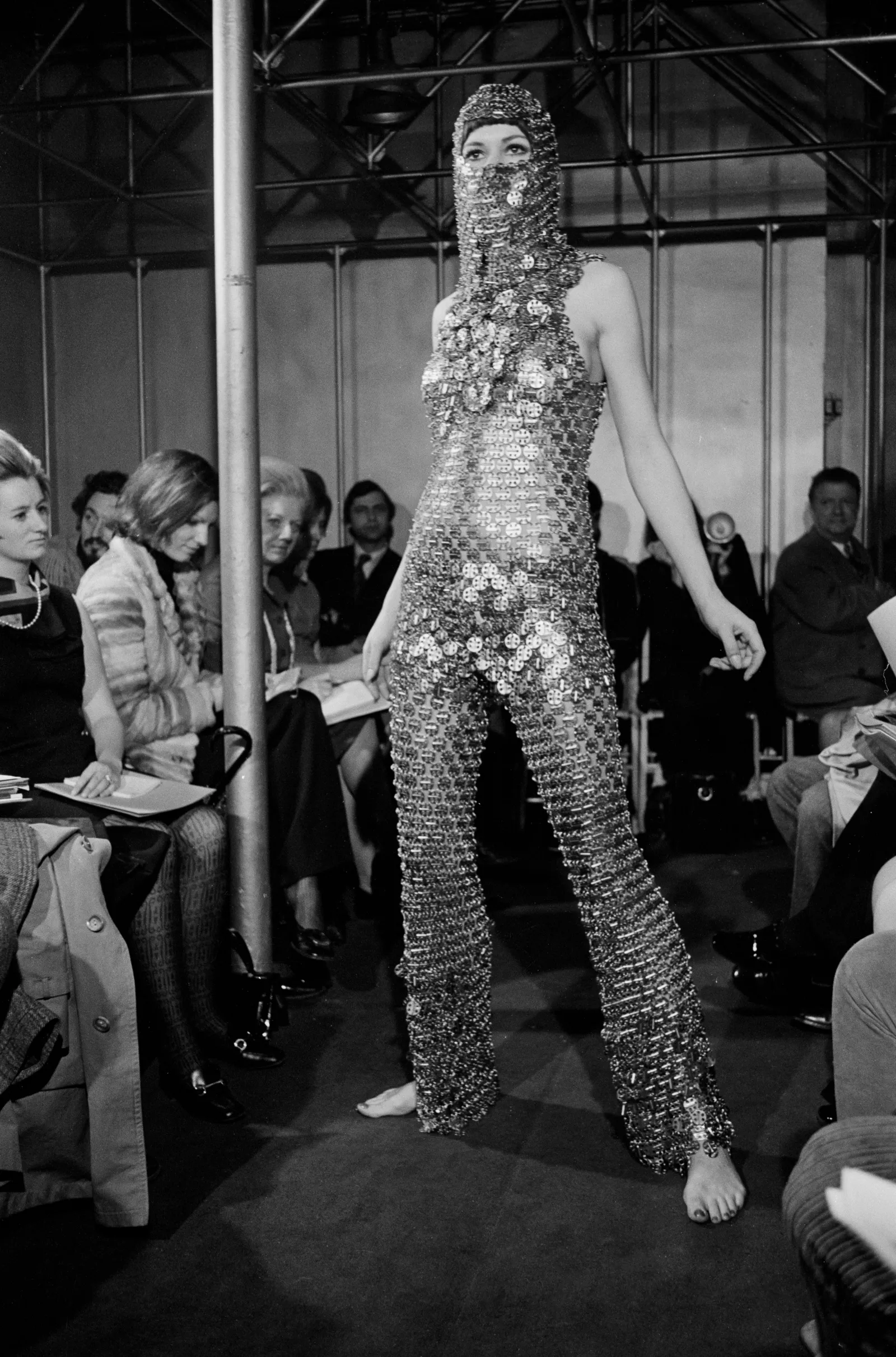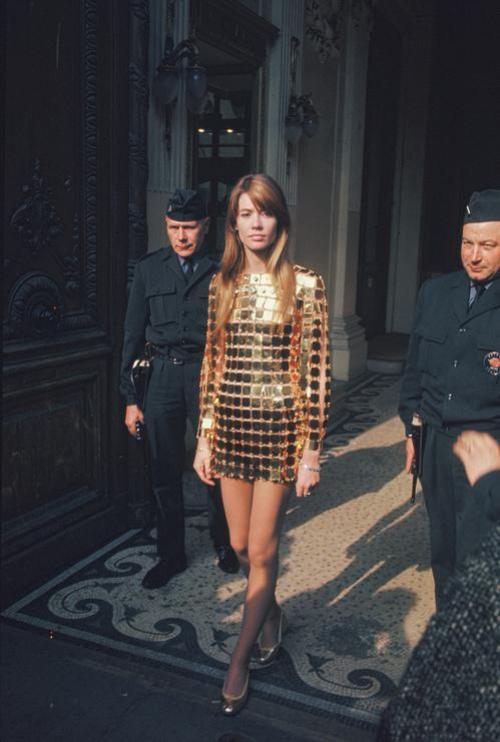Be sure to join us today (July 13) at 9:15 AM PDT (5:15 in London) for BBC's broadcast of the first episode of Star Trek!


by Gwyn Conaway

Paco Rabanne posing with the circular chainmail that has swept Futurist fashion. The style needs no label as it's immediately recognizable as his revolutionary work.
NASA has set its sights on the moon, and their journey is mere days away.
The dead heat of summer has fallen upon us like a humid hug. We fan our sun-kissed skin and drink iced tea from sweating glassware. We crave the artificial breeze of a car ride and press damp rags into our necks. And despite our discomfort, our American breath is frozen in our lungs. Our conversations of anything else have dwindled to distracted murmurs and canceled plans.
I find myself preoccupied with broadcasts and newspapers, my mind muddied with what-ifs and what-thens. It all circles back–one revolution after another–to a single designer and how his first couture line managed to change the course of fashion from the runway to the street. How will he view the coming weeks?
Paco Rabanne.

From Rabanne's "Twelve Unwearable Dresses," 1966.

This first couture collection borrows heavily from the Byzantine period with plate mail and lamellar armor elements, giving his mail dresses an Athenian allure.
Rabanne created his first couture line only three years ago. “Manifesto: Twelve Unwearable Dresses in Contemporary Materials” showed in Paris in 1966, and forever changed the fashion landscape for women. Until that moment on his runway, industrial materials had been relegated to the theatre of war in the forms of chainmail and lamellar armor, among other notable defensive garments.
These days, though, I wonder… Is fashion not also part of the theater of war? Propaganda is considered so, which suggests public perception is a weighty tool of any nation. What better way to proclaim the perfection of one’s ideals than through beauty?

Rabanne designed this in spring of 1969. Note how it mirrors much of the shape language of the height of the Crusades from the 11th to 13th centuries, and Bedouin niqab. This speaks both to the Crusades and the recent Six-Day War in the Middle East.

An example of German hauberk chainmail in the eleventh century.

A Bedouin woman in Sinai, Egypt wearing a niqab adorned with coins sometime between 1900-1920.
Paco Rabanne seems to have reached the same conclusion as me. Though his mother was a chief seamstress for Balenciaga and followed the designer to Paris when he was five, his father was executed during the Spanish Civil War. Of course, I can’t imagine the impact of violence at such a tender age, but politics and doom are common themes of Rabanne’s public statements regarding his own reincarnation and prophecies. Both he and Salvador Dali–who run in the same circles, so I’m told–explore the idea of utter destruction in intimate artistic detail. A political endeavor in and of itself.
So it’s no surprise to me that Paco Rabanne’s construction techniques rely heavily on pliers rather than sewing needles. His unforgiving poeticism armors the modern Cold War woman as if she herself were not just a prize of war, but an active participant.

Francoise Hardy in Rabanne, 1960s. She walks with an air of severity through stately rooms flanked by officers, signaling her authority and power. The untouchable quality of Rabanne's models enhanced their otherworldly power, emulating godly women of history such as Athena, Cleopatra, and Joan of Arc.
Which brings me to one of his most recent masterpieces. Le 69, affectionately known as the Moon Bag, is constructed in the same fashion as his metal and plastic mail dresses with heavy steel. Supposedly inspired by a French butcher’s apron that dates back to the medieval period with a strap made from a toilet-flushing chain, I wonder terribly what his personal feelings are on this accessory. Given our current moment in history, I can’t help but equate it with the covetous nature of the Space Race. Who will get there first? What happens when someone wins the race?
The answer to the first question is imminent. Women will now and for many years carry the “Moon” in their hands as if we have the right to possess it.

Rabanne's "Le 69" Moon Bag.
Paco Rabanne is aware of the inherent violence of his design language. In fact, he has explicitly stated it. “My clothes are like weapons. When they are fastened they make a sound like the trigger of a revolver.” And though many critics cite his architectural background as the reason for his exceptional choices in material and technique, his motivations seem to go deeper than that.
As the Apollo 11 launch approaches, perhaps Rabanne is asking the same questions. What happens when our adversaries see the Moon in our hands?
My only hope is that the doom he feels looming in his prophecies remains there.

![[July 12, 1969] Paco Rabanne and the Theater of War](https://galacticjourney.org/wp-content/uploads/2024/07/Francoise-hardy-in-Rabanne-60s-500x372.jpg)

